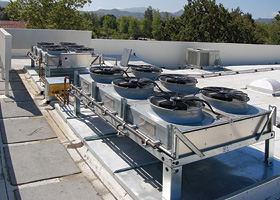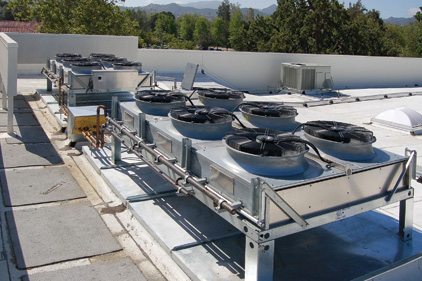CO2 as a refrigerant in cascade supermarket systems, transcritical applications, transport refrigeration, and heat pumps were among major developments in recent years. Here is a summary of those developments.
Cascade
The contractor QPlan installed NH3/CO2 systems for Tesco and Auchan supermarkets over the last three years in Hungary. According to reports, the four systems use ammonia at higher temperatures and CO2 at middle and lower temperatures.

|
| Sprouts supermarket chain had its construction and facilities engineering team work with Hill Phoenix to design and manufacture an R-744 (CO2) cascade system for both low-temperature and medium-temperature applications. |
A NH3/CO2 cascade system was designed to benefit from the positive thermodynamic properties of NH3 at upper temperature (condensation) level (HT) and the transport properties and safety of CO2 at the middle (MT) and lower temperature levels (LT).
In many cascade systems, the upper stage serves as condenser for the lower stages, Qplan’s cascade uses the upper ammonia stage both for indirect cooling on HT level and as a condenser for the CO2 refrigeration cycle on LT level. Indirect cooling on HT level uses also CO2 as a two-phase coolant.
According to a report published at the website R744.com, “The upper stage is a regular NH3 cycle consisting of screw compressors, an evaporative condenser, devices for thermosyphon oil cooling and for economizer, a liquid separator, and a plate heat exchanger (PTHE). The primary side of PTHE works as a gravity-flooded evaporator with NH3.
“The secondary side is divided into two parts. Part one functions as a regular condenser for LT and part two as a condenser for the passive-cooling cycle for the coolant of CO2. This CO2 coolant circulates in a closed system consisting of a liquid separator, pumps, and HT evaporators where the pumps deliver the liquid from the liquid separator into the evaporators, the vapor, returned from evaporators, condenses in the part two of the heat exchanger and the condensate flows into the separator, closing the cycle. The LT cycle is a regular DX system as a consequence of the relative small load, but there is no objections for applying flooded system to it.”
In another approach in recent years regarding cascade in supermarkets, the Sprouts supermarket chain had its construction and facilities engineering team work with Hill Phoenix to design and manufacture an R-744 (CO2) cascade system for both low- and medium-temperature applications (branded as Second Nature MT2LX). The systems consist of two independent-refrigeration systems that share a common cascade heat exchanger. The upper-cascade system is a reduced-charge HFC system that cools the CO2 in the lower cascade. The HFC system rejects heat to ambient through the condenser, in this case an air-cooled, micro-channel condenser.
Transcritical
In 2012, Bitzer Brazil announced what it said was the first CO2 trans-critical system in the Americas. The company said it built a fully functional unit as a CO2 supermarket booster system. It was placed at the company’s training center to provide a hands-on experience for refrigeration contractors and technicians.
The system is built as a booster system with gas bypass. The gas from the low-pressure compressor is mixed with gas from the gas bypass as well as from the medium-temperature evaporators. The gas that exits in the low-temperature compressor is cooled and can then safely enter the high-temperature compressor. The booster principle is used because it gives a safe oil return and good system efficiency, the company said.
Transport
During a seminar in 2012 in Bangkok, the topic of transportation refrigeration was discussed.
Kartik Kumar, from Carrier Transicold USA, updated participants on transport refrigeration solutions and CO2 shipping container, which the company is currently testing.
Kumar said that about 100,000 refrigerated containers are currently in service around the world. Emissions from shipping represent around 3 percent of the total CO2 emissions. He said main challenges in container refrigeration is that one unit has to be suitable for ambient temperature from -35 to 35˚C. Manufacturers need to provide equipment with at least a 15-year-long life cycle and the total carbon footprint during the whole life cycle of the product has to be considered, he said.
Together with an industry consortium, Carrier Transicold has developed software, called QUEST, to improve energy efficiency and reduce the environmental impact of refrigeration units, the company said. QUEST maintains cargo temperature based on pre-defined parameters.
Until now, the system has been tested with HFC-134a, but according to Kumar, the efficiency of transport refrigeration could be improved even further since technology advances have been made in CO2 refrigeration systems. (Carrier has recently introduced NaturaLine, a new container generation using CO2.) He said current sea tests seem to be encouraging as the NaturaLine has already shown the same efficiency as the most efficient unit in place now.
Kumar said Carrier Transicold’s objective is to help the container industry reach 100 percent CO2 container refrigeration. He indicated that the use of any synthetic refrigerant should only be intermediary.
Heat Pumps
At the Chillventa expo in Germany in October 2012, high-temperature heat pump specialist Thermea showed the new ThermeCO2 ADR - air dryer with reciprocating compressor. The company also reported on successful applications for its 1,000 kW capacity ThermeCO2 high-temperature heat pump in Poland and the Seychelles.
According to the company, the air dryer “can set new standards for compressed air dryers with natural refrigerants regarding heat recovery and energy efficiency. These machines use CO2 as the refrigerant and can be also used as a replacement for R-22 systems.
The high-temperature heat pumps in the Seychelles, an island country in the Indian Ocean, had “a capacity of 180 kW each planned for this year to make sure that the guests of a hotel can always enjoy pleasant temperatures,” the company said. In addition to the preparation of service water cooling of the building complex, cooling will also be provided.
Publication date: 2/11/2013



Report Abusive Comment